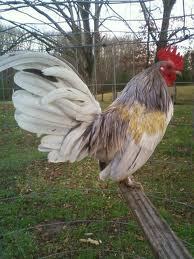whats the difference between blue and recessive chocolate?..
for one Blue is autosomal(not sex linked), Blue is incompletely dominant and incompletely penetrant(source https://www.backyardchickens.com/t/...-vs-complete-dominant-vs-incomplete-penetrant) two copies of blue will produce whats called splash. since this gene is incompletely dominant some black feathers are to be expected, while a breeder can do all he can to try to avoid this, this will happen in at least one bird.. Blue is incapable of diluting Pg(Pattern gene) and Melanotic(Ml) on a Extended black background(self black birds based on the Extended black e allele).
Chocolate(choc) is a recessive sexlinked gene. needs two copies on the males to be expressed, but the females need only be Hemizygous for it(choc/-).. chocolate is not known to be a leaky gene, chocolate is capable of diluting Pg and Ml on any background...
let see how both gene works on the same flock(source http://www.orpingtonbantams.co.uk/)
Black Hen(source http://www.orpingtonbantams.co.uk/black.htm)

Blue Hen(one copy of Blue Bl/b+)

Chocolate hen(one copy of chocolate choc/-)

you see how choc dont have dark lacing around like blue? thats because they work differently..
now what would happen if you mix choc and blue?.. long ago I predicted the outcome.. a light chocolaty color(thanks to Blue and chocolate working on the body at the same time) body and chocolate outer lacing.. Why? well again , blue is incapable of diluting Pg and Ml on a E background, leaving the outer lacing of the boy to be diluted only by chocolate..
this color is known as Mauve
.
for one Blue is autosomal(not sex linked), Blue is incompletely dominant and incompletely penetrant(source https://www.backyardchickens.com/t/...-vs-complete-dominant-vs-incomplete-penetrant) two copies of blue will produce whats called splash. since this gene is incompletely dominant some black feathers are to be expected, while a breeder can do all he can to try to avoid this, this will happen in at least one bird.. Blue is incapable of diluting Pg(Pattern gene) and Melanotic(Ml) on a Extended black background(self black birds based on the Extended black e allele).
Chocolate(choc) is a recessive sexlinked gene. needs two copies on the males to be expressed, but the females need only be Hemizygous for it(choc/-).. chocolate is not known to be a leaky gene, chocolate is capable of diluting Pg and Ml on any background...
let see how both gene works on the same flock(source http://www.orpingtonbantams.co.uk/)
Black Hen(source http://www.orpingtonbantams.co.uk/black.htm)
Blue Hen(one copy of Blue Bl/b+)
Chocolate hen(one copy of chocolate choc/-)
you see how choc dont have dark lacing around like blue? thats because they work differently..
now what would happen if you mix choc and blue?.. long ago I predicted the outcome.. a light chocolaty color(thanks to Blue and chocolate working on the body at the same time) body and chocolate outer lacing.. Why? well again , blue is incapable of diluting Pg and Ml on a E background, leaving the outer lacing of the boy to be diluted only by chocolate..
this color is known as Mauve
.


